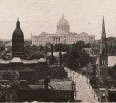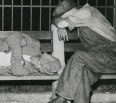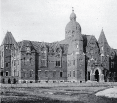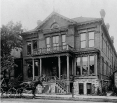As America’s frontier transforms from a land of farmers to a land of dirty, dangerous and congested cities, many groups step in to cope with the growing number of social ills, from pregnancy out of wedlock to hunger and homelessness among St. Paul’s poorest citizens.
For example, the Women’s Christian Home, a home for so-called “fallen women,” comes into being in 1872 when a girl of 16 appeals for help to the president of the Women’s Christian Association. “The girl had no kin on earth that she knew,” Ethel McClure writes. “She was betrayed — an outcast: lying, foul-mouthed and thievish.” Later, “five girls, all inmates of houses of ill fame, came in a body, seeking help to turn from lives of shame.”
Most charities at this time focus on specific needs and communities, such as the St. Paul branch of the Needlework Guild of America that makes clothes for the poor. Others include the Jewish community’s Neighborhood House on St. Paul’s West Side, the Hebrew Ladies’ Aid Society, the Jewish Relief Society, the Guild of Catholic Women and the German Aid Society, to name only a few.
Photos courtesy of the Minnesota Historical Society.




